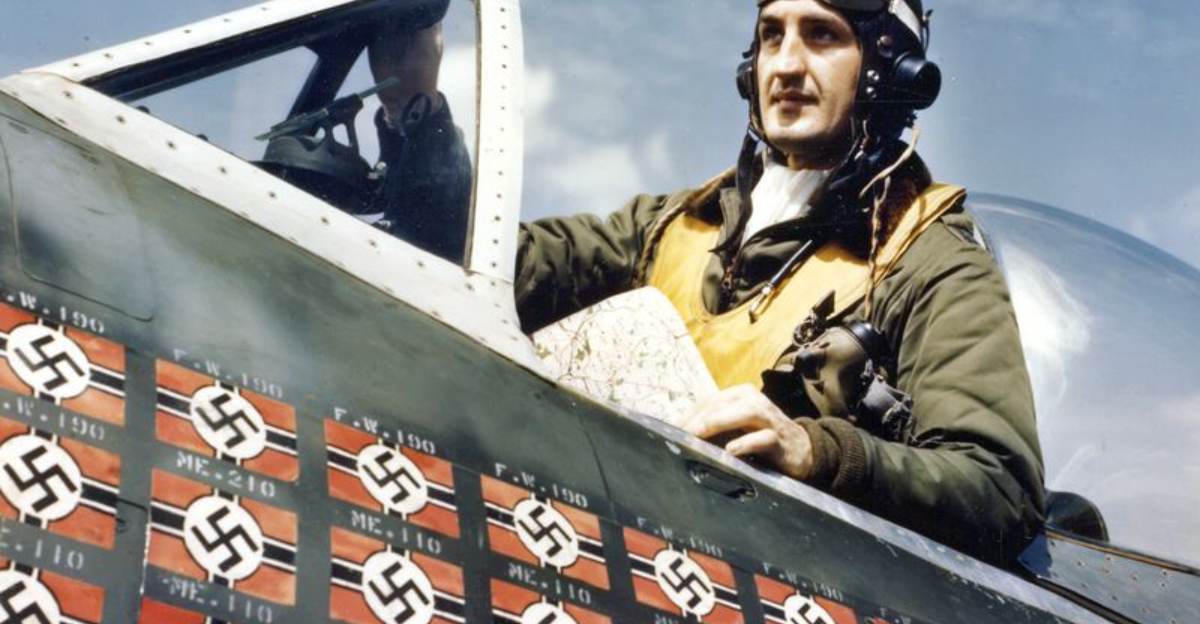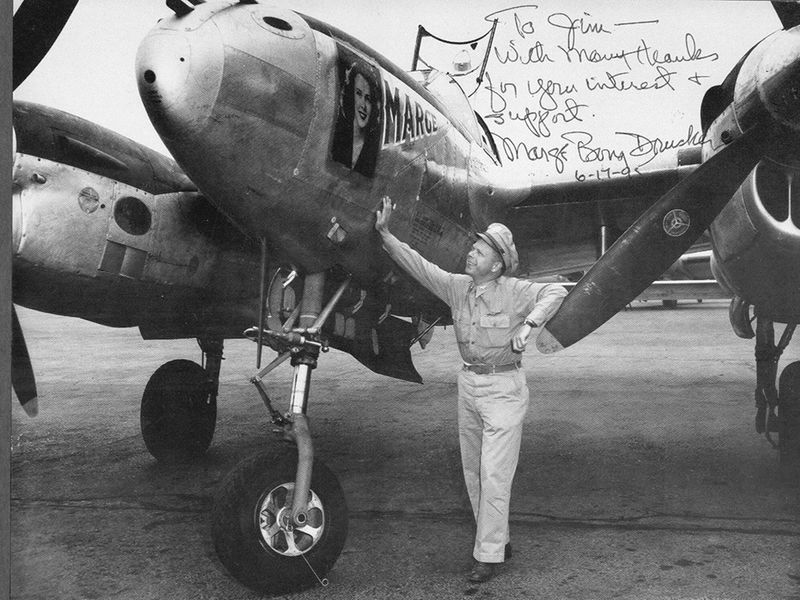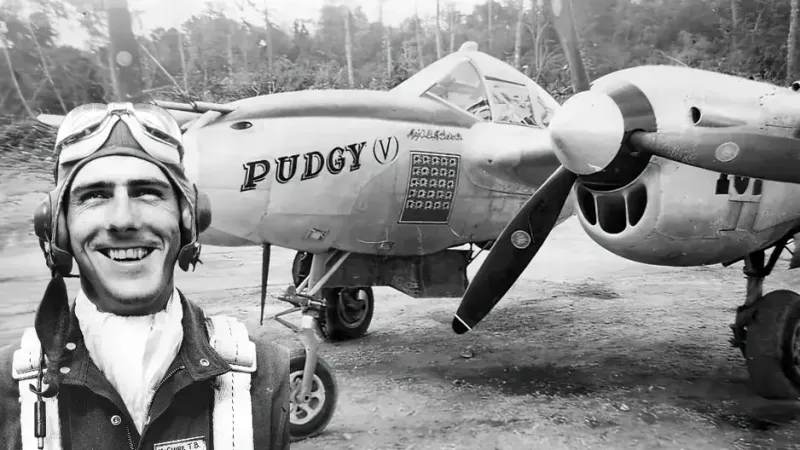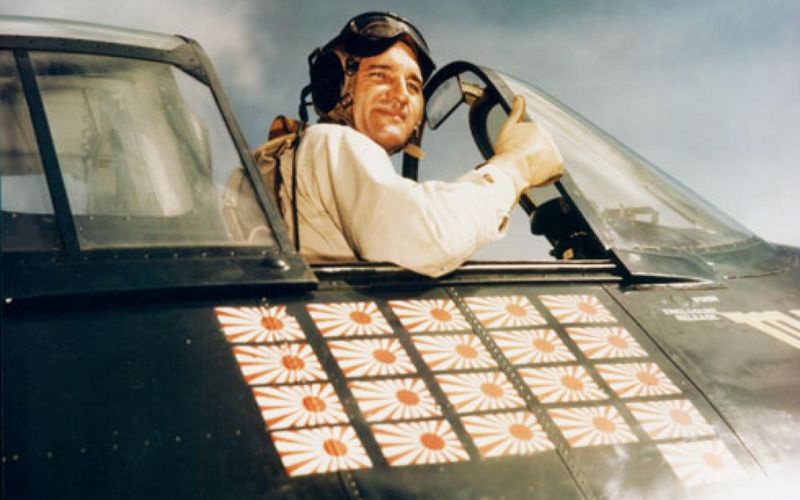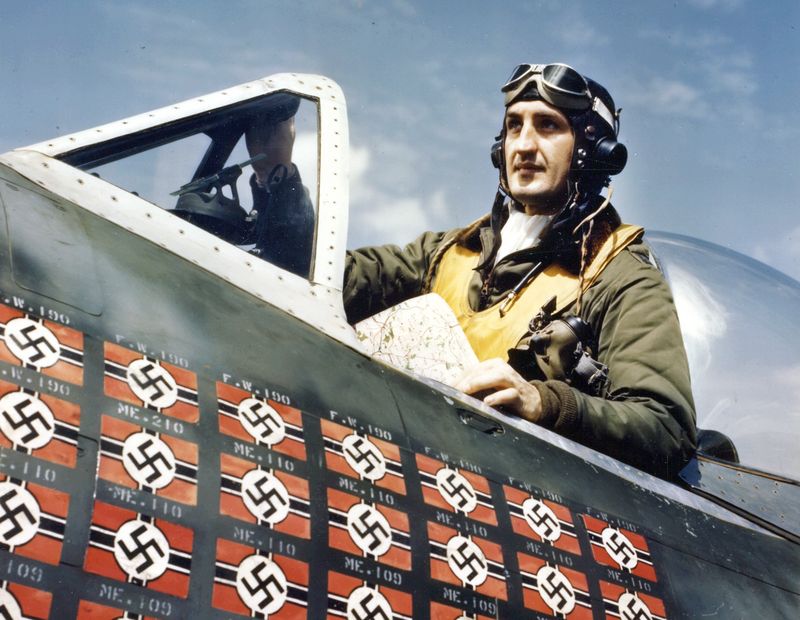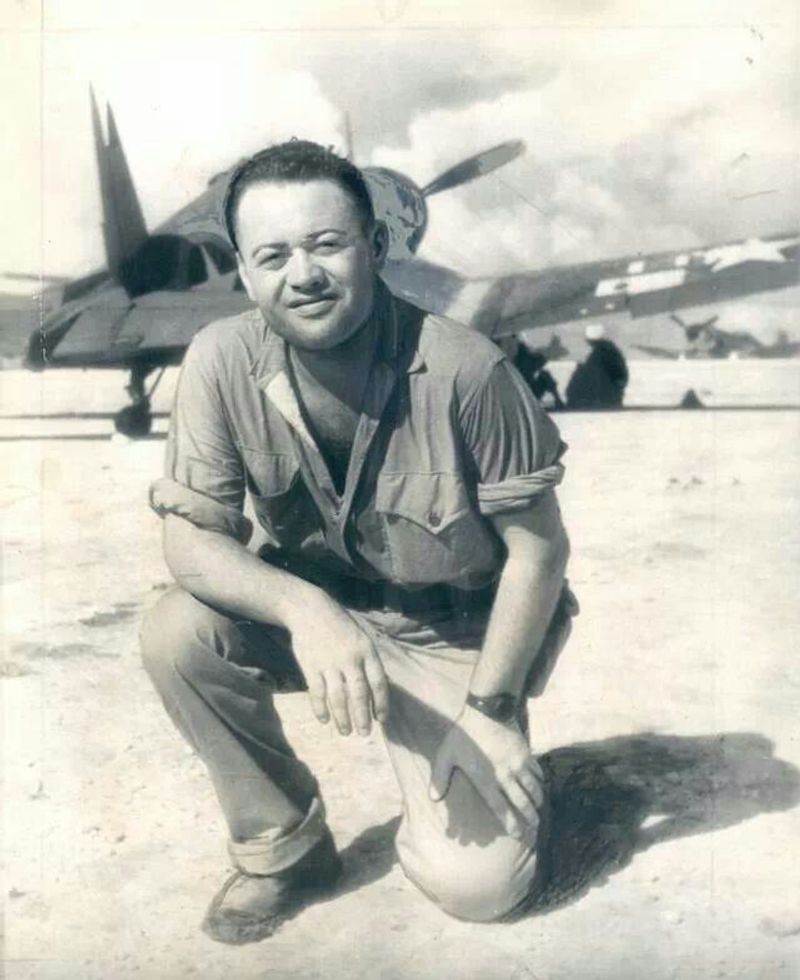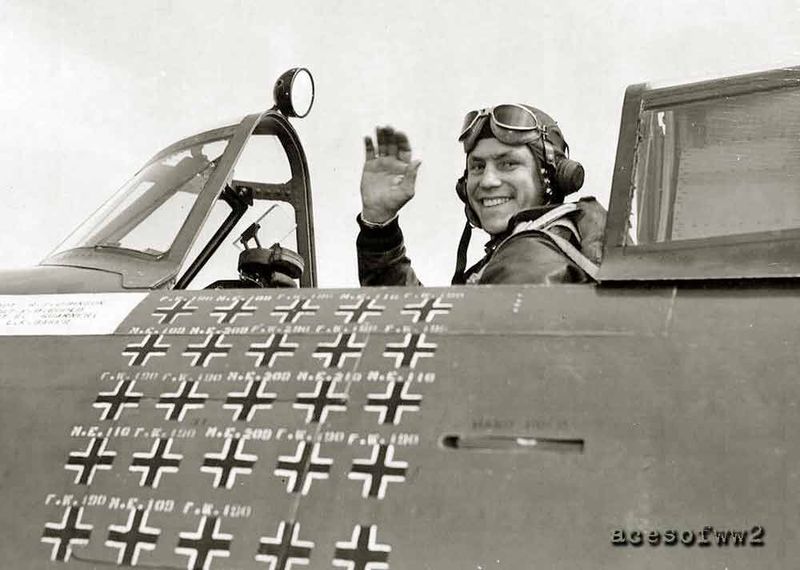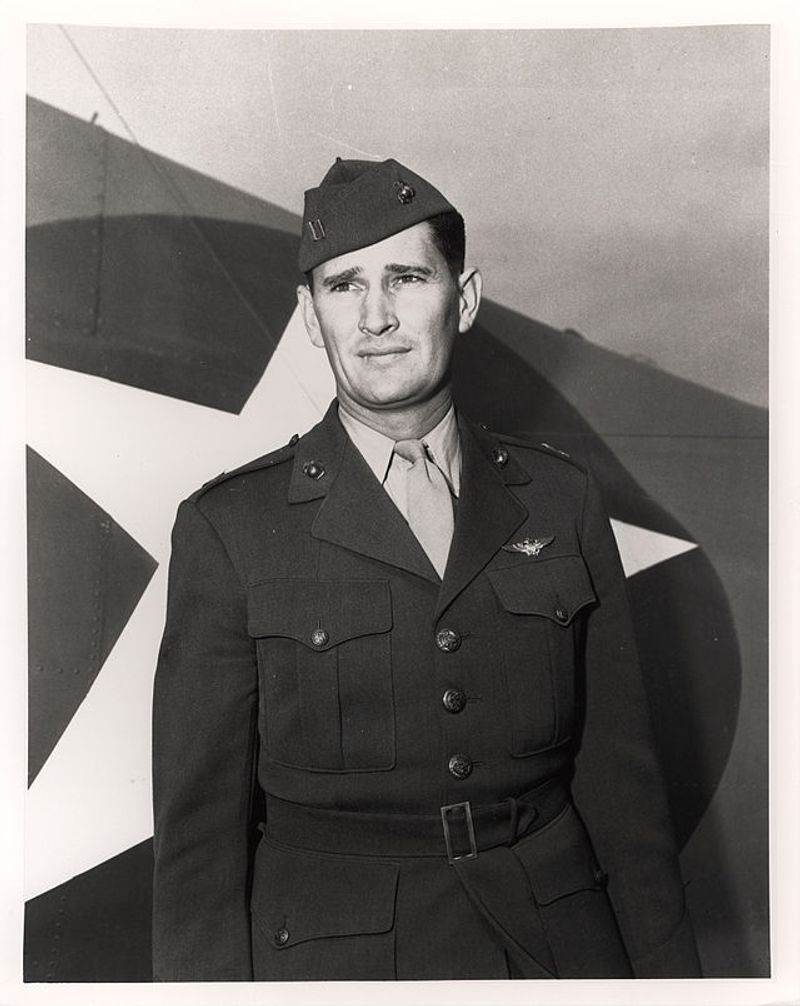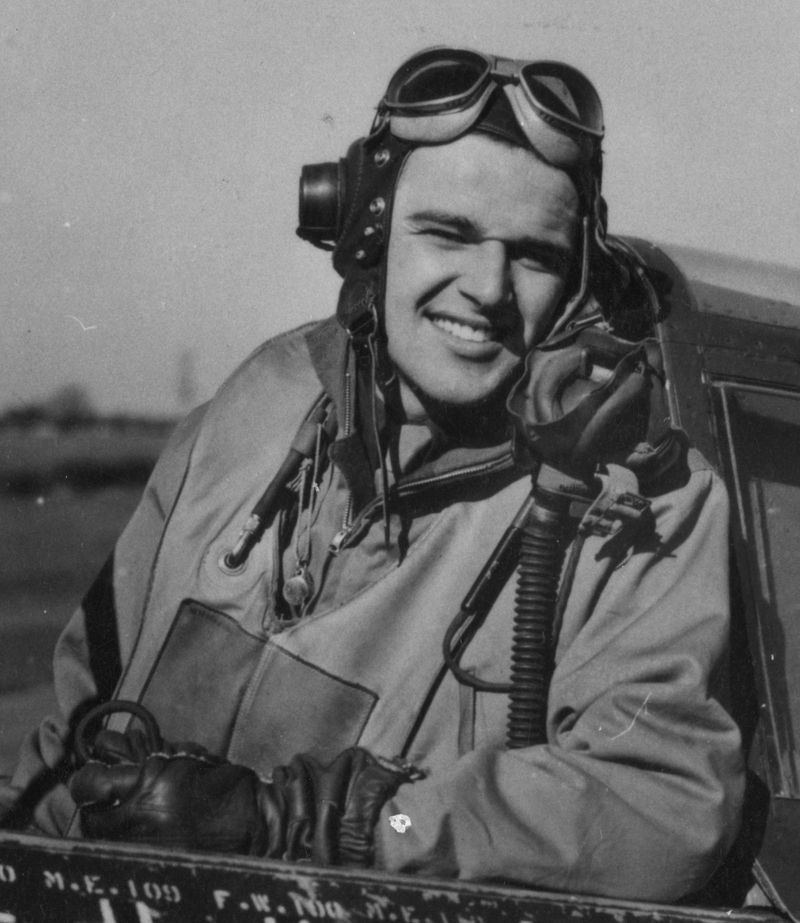Throughout aviation history, American fighter pilots have shown extraordinary courage and skill in aerial combat. These elite airmen achieved remarkable victory totals against enemy aircraft during World War II and the Korean War. Their incredible accomplishments helped secure Allied air superiority and ultimately contributed to victory in these conflicts. Let’s explore the stories of America’s eight deadliest fighter aces and the remarkable aerial combat records they established.
1. Richard Ira “Dick” Bong (USAAF, WWII) – Credited with 40 Japanese aircraft shot down, the highest total of any American ace
Known as the “Ace of Aces,” Major Richard Bong flew his P-38 Lightning with deadly precision in the Pacific Theater. The Wisconsin farm boy initially struggled with formation flying but found his calling in aerial combat, downing five enemy planes to earn ace status by January 1943. Bong’s gentle personality contrasted sharply with his lethal effectiveness in the skies. He often avoided shooting down enemy pilots who had bailed out, showing rare compassion amid brutal warfare. Tragically, Bong died on August 6, 1945—the same day as the Hiroshima bombing—while testing a P-80 jet fighter in California. His legacy lives on through the Richard I. Bong Veterans Historical Center in Superior, Wisconsin.
2. Thomas Buchanan McGuire Jr. (USAAF, WWII) – Shot down 38 enemy planes, making him the second-highest-scoring American ace
Major McGuire embodied fierce determination in the cockpit, pursuing aerial victories with almost reckless abandon. His aggressive flying style and exceptional marksmanship made him a nightmare for Japanese pilots encountering his P-38 Lightning over the Pacific. Unlike some aces who sought publicity, McGuire focused intensely on combat effectiveness. He constantly studied enemy tactics and aircraft capabilities, giving him crucial advantages during split-second dogfight decisions. McGuire’s brilliant career ended during a low-altitude dogfight on January 7, 1945, when his P-38 stalled and crashed while pursuing a Japanese fighter. He received the Medal of Honor posthumously, and McGuire Air Force Base in New Jersey stands as a testament to his extraordinary combat record.
3. David McCampbell (USN, WWII) – The Navy’s all-time leading ace with 34 aerial victories; also set the U.S. single-mission record of nine kills on 24 October 1944
Commander McCampbell achieved something seemingly impossible on October 24, 1944, during the Battle of Leyte Gulf. Flying his F6F Hellcat, he single-handedly engaged 60 Japanese aircraft, shooting down nine and damaging another—all in one mission! When low on ammunition and fuel, he radioed simply: “I’m coming home now. I’ve got nine planes and need fuel.” At 34, McCampbell was older than most fighter pilots when he began his combat career. As air group commander aboard USS Essex, he combined tactical leadership with personal courage. His incredible record of 34 aerial victories makes him the top Navy ace of all time. McCampbell’s Medal of Honor citation called his combat flying “brilliant,” an understatement for this legendary aviator.
4. Francis “Gabby” Gabreski (USAAF/USAF, WWII & Korea) – Credited with 34½ total victories (28 in WWII, 6½ in Korea), the top American ace in the European Theater
The son of Polish immigrants, Colonel Gabreski earned his nickname “Gabby” ironically—he was actually quite reserved. His combat career spanned two wars and featured remarkable consistency, as he mastered both propeller fighters in WWII and jets in Korea. During WWII, Gabreski flew with the RAF’s Polish Squadron before joining the 56th Fighter Group, where he scored 28 victories in his P-47 Thunderbolt. After becoming a German POW late in the war, he returned to combat years later in Korea. Few pilots successfully transitioned between such different aircraft and combat environments. Gabreski’s adaptability and longevity make him unique among American aces, demonstrating exceptional skill across multiple generations of fighter aircraft.
5. Gregory “Pappy” Boyington (USMC, WWII) – Shot down 28 Japanese aircraft, the highest total for a Marine Corps ace
Colonel Boyington lived a life that Hollywood couldn’t have scripted better. Before America entered WWII, he flew with the legendary Flying Tigers in China. Later, despite being considered too old for combat flying at 31, he formed the famous “Black Sheep” Squadron, officially Marine Fighter Squadron 214. Hard-drinking and rebellious, “Pappy” earned his nickname as the elder statesman among younger pilots. His leadership philosophy was simple: lead from the front and by example. Shot down in January 1944, Boyington survived 20 brutal months in Japanese prison camps. His Medal of Honor was actually approved while he was presumed dead. The 1970s TV show “Baa Baa Black Sheep” introduced his larger-than-life story to new generations.
6. Robert S. “Bob” Johnson (USAAF, WWII) – Credited with 27 victories in the European Theater, the fourth-highest American total in WWII
Lieutenant Colonel Johnson embodied perseverance in the cockpit. Early in his combat career, his P-47 Thunderbolt absorbed over 200 machine gun rounds during a savage dogfight, yet he managed to return to base. This experience earned his aircraft the nickname “Lucky.” Johnson’s rivalry with fellow ace Gabby Gabreski became legendary within the 56th Fighter Group. Their friendly competition pushed both men to extraordinary achievements as they hunted German aircraft over Europe. Unlike many aces who relied on natural talent, Johnson credited methodical practice and intense study of aerial combat tactics. His autobiography, “Thunderbolt!”, provides rare insights into the psychological challenges fighter pilots faced during extended combat tours over Nazi-occupied Europe.
7. Joseph J. “Joe” Foss (USMC, WWII) – Shot down 26 enemy planes over Guadalcanal, becoming America’s first “Ace-of-Aces”
Major Foss entered combat relatively late at age 27, but quickly made up for lost time. Leading “Foss’s Flying Circus” over Guadalcanal in 1942-43, he achieved his remarkable victory total in just 63 days of intense combat against experienced Japanese pilots. President Roosevelt personally presented Foss with the Medal of Honor. His farm-boy background and straightforward personality made him a natural media hero during war bond tours across America. After WWII, Foss built an astonishing post-military career: South Dakota governor, first commissioner of the American Football League, and president of the National Rifle Association. His combat exploits during the desperate early days of the Pacific War remain his most enduring legacy.
8. Walker M. “Bud” Mahurin (USAAF/USAF, WWII & Korea) – Credited with 24.25 victories (20.75 in WWII, 3.5 in Korea), the first American pilot to score kills in both European and Pacific theaters
Colonel Mahurin’s combat career featured extraordinary versatility across theaters and aircraft types. His initial success came in Europe flying P-47 Thunderbolts with the 56th Fighter Group, where he became one of the unit’s top aces. After being shot down over France in 1944, Mahurin evaded capture with help from the French Resistance. Reassigned to the Pacific, he achieved the rare distinction of scoring victories in both major theaters of WWII. During the Korean War, Mahurin commanded the 4th Fighter Interceptor Group before being shot down again—this time enduring 16 months as a North Korean prisoner. His remarkable resilience across three different combat assignments places him among America’s most experienced fighter pilots.
